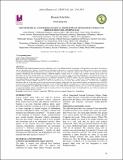Phytochemical and pharmacological properties of methanolic extract of ardisia humilis vahl (myrsinaceae)
Date
2013Auteur
Khatun, Amina
Rahman, Mahmudur
Kabir, Sumaiya
Akter, Md Nahid
Chowdhury, Sadia Afreen
Metadata
Afficher la notice complèteRésumé
Ardisia humilisVahl. (Family-Myrsinaceae) has been traditionally used by the folklore medicinal practitioners of Bangladesh to treat cancer, heart diseases and liver poisoning
where cytotoxic, thrombolytic and antioxidant medications are implicated. Besides, some other species of Ardisia were reported to have incriminated properties and chemical
constituents. In this study, the crude methanolic extract of the A.humilis was evaluated for its possible cytotoxic, thrombolytic and antioxidant activities in different methods to justify some of its folklore use. Cytotoxic property of the extract was determined against brine shrimp nauplii. The thrombolytic activity was evaluated using the standards treptokinase.The antioxidant activity was measured using free radical scavenging activity with 2-2-diphenyl,1-
picrylhydrazyl (DPPH) method. The extract showed significant cytotoxic effect in brine shrimp lethality bioassay where it showed the value of LC 50 and LC90 2.26 μg/ml and 7.13μg/ml after 24 hours respectively. The standard cytotoxic drug vincristine sulphate showed LC50 and LC90 of 0.81μg/ml and 6.33 μg/ml after 24 hour respectively. The study
gave a significant indication of the use of the plant extract as a potential source for cytotoxic compounds. The extract showed moderate thrombolytic activity of 33.33% clot lysis where the standard streptokinase showed that of 84%. In DPPH free radical scavenging test, IC
50 value for the methanolic crude extract was found fairly significant (4.305 μg/ml) while compared to the IC50 value of the reference standards ascorbic acid (2.8 μg/ml). The obtained results tend to suggest the probable cytotoxic, thrombolytic and antioxidant activities of the methanolic extract of A. humilis justify its use in folkloric remedies and those activities of other species of Ardisia.

